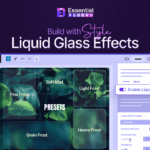Custom post templates are like a blank canvas for your digital storytelling. They go beyond mere aesthetics, offering a customized and consistent design that keeps readers engaged from the moment they land on your site. It can help you establish a recognizable and appealing style where you are not just sharing content—you are creating a memorable brand presence.
Do you want to transform your WordPress site into a distinctive digital hub that showcases your creativity and professionalism? Creating custom WordPress post templates can be a way. In this blog, we will show you how to design custom post templates in Block Editor. You will learn how to simplify content creation, save time and elevate the look and feel of your website.

WordPress Post Template: What It Is & Why Are They Useful?
A WordPress post template is a preset layout that structures your posts in a particular style, making it easy to maintain a cohesive look across your content. Instead of starting each post from scratch, you simply select a template, and the layout, fonts, image placements and other design elements are ready.
Custom templates are especially useful if you often need layouts that deviate from the default single-post design. By creating your templates, you can focus on writing content without rearranging blocks every time, which enhances productivity and allows for consistency.
Advantages of Using Custom WordPress Post Templates
Custom post templates offer multiple benefits, whether you are a blogger, marketer or web designer. These templates let you set up predefined layouts that ensure every post you publish has a consistent, unique look, saving you time and enhancing user experience. Here is why you should consider creating them.
🎯 Consistency: Using templates ensures a unified appearance, making your site look polished and professional. This is particularly helpful for blogs, where consistent design—like font styles and image placements—creates a cohesive user experience.
🎯 Efficiency: Custom templates eliminate repetitive setup work, letting you start writing without arranging blocks or widgets each time. This is especially advantageous for high-volume publishers or bloggers who want to streamline their workflow.
🎯 Enhanced Design: Templates allow for visually appealing layouts tailored to your audience’s needs. The Block Editor’s drag-and-drop functionality makes it easy to integrate dynamic elements, custom headers, and more.
🎯 Time-Saving: Post templates remove repetitive tasks, which means less time on setup and more time focusing on content quality.
Use Cases of Custom WordPress Post Templates
Custom post templates are versatile, allowing you to create layouts for specific post types or purposes. Here are some examples of when custom templates can be especially useful.
👉 Blog Posts: Standardize headings, fonts, and image placements to maintain a uniform look across all articles. This consistency helps build brand recognition and provides a more professional reading experience for your audience.
👉 Landing Pages: Build conversion-focused templates with eye-catching calls-to-action and minimal distractions for better audience engagement. By strategically designing these templates, you can guide visitors through a carefully crafted journey that maximizes the likelihood of conversion.
👉 Product Reviews: Create templates that highlight essential features, pros and cons, and testimonials in an organized manner. These structured layouts help readers quickly get crucial information, making decision-making easier and more transparent.
👉 Portfolios: Use templates that spotlight visual content, creating a clean layout for showcasing projects, images, or videos. A well-designed portfolio template can transform your work from a simple collection of images to a compelling visual narrative that captures potential clients’ attention.
In addition to creating templates for post types, you can also experiment with layout styles such as full-width designs for image-heavy posts, sidebars for extra navigation or information, grid layouts for portfolios, or custom headers and footers that feature unique navigation links or branding elements.
Steps to Create Custom Post Templates in WordPress Block Editor?
The WordPress Block Editor is user-friendly and makes designing custom layouts intuitive, even for those without coding experience. Here is a step-by-step guide to creating custom post templates with the Block Editor:
Step 1: Access the Template Editor
To create custom post templates, first, log into your WordPress dashboard and navigate to ‘Appearance’ > ‘Editor‘.
Now, to create custom post templates, move to ‘Templates’ > ‘Add New Template‘. Here, you will be able to create a new template from scratch or edit an existing one.
Step 2: Choose the Template Type
Select the type of template you want to create, such as a post, page, or custom post type. For this example, choose a “Post” template if you are creating one for blog posts. Selecting this will determine how WordPress applies the template across your site.
Step 3: Build Your Custom Template
Now comes the fun part—designing your layout. You can either choose a ready pattern as displayed below or use the Block Editor’s drag-and-drop interface to add headers, footers, images, and text blocks.
For instance, if you want to create a template for travel blog posts where you want to add images first, you may add a gallery block, multi-column section for text or images, and keep a section for your social media profiles or YouTube channel.
Or, if you are building a template to showcase a roadmap, you might use headline blocks, sections for text or images, timeline blocks to detail guide, and a call-to-action block at the end. Customize each block’s settings to get your desired layout and then save your template when finished.
Step 4: Use the New Template in a Post
To apply your new template to a post, open any post in the Block Editor and check the Post Settings sidebar. Once you ‘Save’ the new template, it becomes the default post template. Now, open a post in the block editor and click on ‘Show Template’ from the post settings sidebar. The custom post template you created will appear instantly.
You can switch between the templates. Click on ‘Swap Template’ with the one you created, instantly transforming the layout according to your design.
Benefits & Drawbacks of Using the Block Editor for Custom Post Templates
While the Block Editor offers a user-friendly, straightforward way to create post templates, it does have its limitations. Here is a quick look at the pros and cons:
Advantages of Block Editor for Custom Post Templates
User-Friendly: The intuitive, drag-and-drop interface makes the Block Editor accessible for all skill levels. This approach significantly reduces the learning curve for content creators, allowing even novice users to build professional-looking layouts with ease.
Built-In Functionality: Since the Block Editor is part of WordPress, you do not need extra plugins or tools. This native integration ensures better performance and compatibility across different WordPress themes and plugins.
Reusable Blocks: You can save blocks or layouts for future use, speeding up the content creation process. This feature is particularly valuable for content teams looking to maintain consistency and efficiency in their publishing workflow.
Disadvantages of Block Editor for Custom Post Templates
Limited Customization: While perfect for basic layouts, the Block Editor may lack advanced customization options for more complex designs. Web designers and developers might find the built-in options restrictive compared to more flexible page-building tools.
Advanced Needs: You might need additional plugins or custom code for intricate layouts. This can potentially increase development time and complexity, especially for websites requiring highly specialized design elements.
Personalize Your Content Creation Process with Custom WordPress Post Templates
Do not just publish content—create experiences. Experiment with different template designs, listen to your audience’s feedback, and continuously refine your approach. The beauty of the Block Editor is its flexibility—you can iterate, adjust, and perfect your templates with remarkable ease.
Your content deserves to stand out. With custom post templates, you are not just streamlining your workflow; you are elevating your entire digital presence. So, take the leap, unleash your creativity, and watch as your WordPress site transforms from ordinary to extraordinary.
Was this blog helpful? To get more blogs like this, subscribe to our blogs and join our Facebook community to stay connected.




